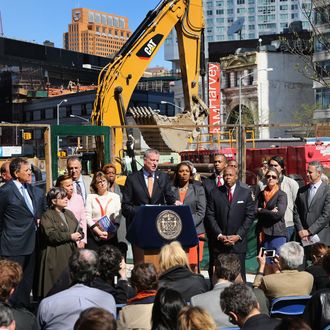
Could there be a more soporific or cryptic string of words than mandatory inclusionary zoning, the new rallying cry in the fight to make New York a place where New Yorkers can afford to live? And yet it’s an exciting concept, especially if your rent-regulated apartment is going co-op and you can’t afford to stay, or if you’ve fought to make your neighborhood a more pleasant place to live and now your children can no longer afford to live where they grew up. The city is drowning in its own money, and this is a lifejacket for those who can’t swim.
Bill de Blasio has been talking about mandatory inclusionary zoning since before he was elected mayor, and now he’s laid out a way to make it work. It’s not a magic wand, but it is a powerful tool that, properly wielded, could make the city both more desirable and more affordable, an apparently insoluble paradox. The city needs huge quantities of housing of every kind (except for plutocrat penthouses: We’re all set with those, thanks). The new proposal should help.
As the city grows, the real-estate market keeps puffing up, and low-income residents feel more and more squeezed by other people’s affluence, the city is hunting for urban sponges — neighborhoods like East New York, Jerome Avenue in the Bronx, and a portion of downtown Flushing, that can absorb a lot more people without too much pain. But New York has a bifurcated market: areas so expensive that developers build only for the rich, and areas so depressed that developers don’t want to build there at all. Either way, most people have nowhere to go. In this sick ecosystem, creating more supply seems only to whip up greater demand, and the promise of new construction has a tendency to make neighborhoods more expensive. Even in East New York.
As poor but promising areas are rezoned, the new proposal offers a carrot of subsidy and a stick of obligation: Developers can tap into city money, but they must set aside between 25 and 30 percent of all new apartments for low- and middle-income residents. The key word is must. In the existing system, developers trade regulated apartments for tax incentives. Under the de Blasio proposal, whenever a neighborhood is rezoned (or a developer asks for a special rezoning), the builder can no longer opt out. Even more important, those regulated apartments will stay regulated forever.
That’s an expensive proposition: $6.7 billion in housing subsidies over the next decade, plus another billion or so to bring rezoned neighborhoods up to snuff. “This isn’t just an issue of equity; it’s also an issue of growth,” says city planning commissioner Carl Weisbrod. In more affluent areas, developers will have to build the affordable (i.e. money-losing) apartments themselves, which effectively means that well-off residents subsidize their less affluent neighbors. (That, more or less, is what taxes do, too.)
If the de Blasio program becomes law, and if that law works as advertised, it could help keep the poor, the rich, and the middle class from separating in the centrifuge of a dizzying market. It might even cause New York to start emulating cities like Vienna, where new social housing is often beautiful, solid — and cheap.






























